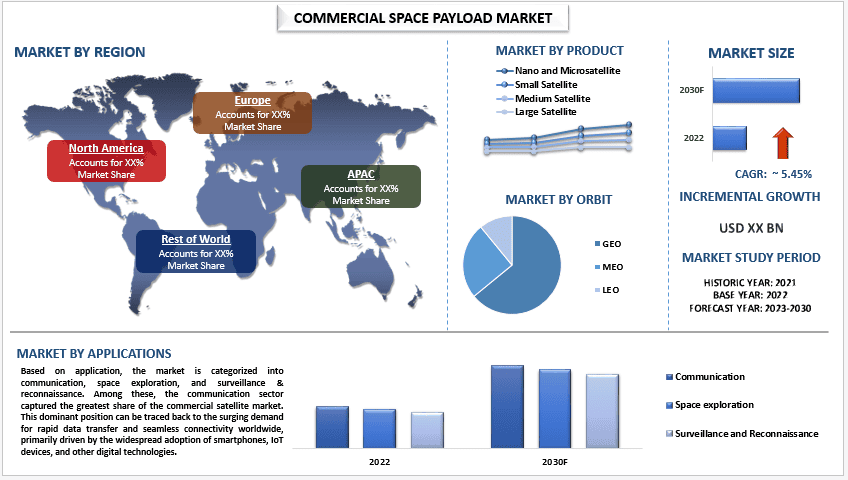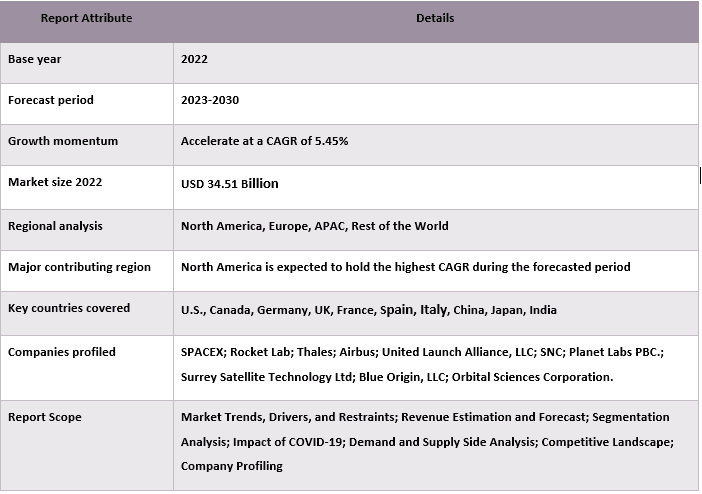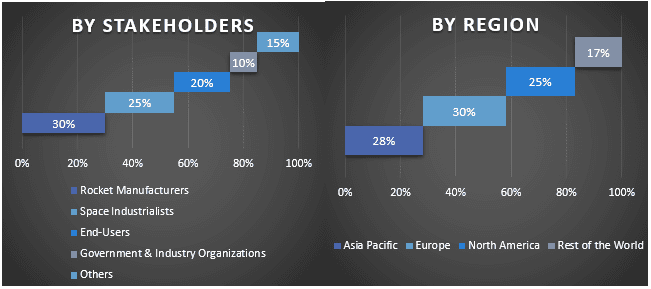- Inicio
- Acerca de nosotros
- Industria
- Servicios
- Leyendo
- Contáctenos
Mercado de Carga Útil Espacial Comercial: Análisis Actual y Pronóstico (2023-2030)
Énfasis en el Producto (Nano y Microsatélites, Satélite Pequeño, Satélite Mediano y Satélite Grande); Órbita (GEO, MEO y LEO); Aplicación (Comunicación, Exploración Espacial y Vigilancia y Reconocimiento) y Región/País

El mercado de carga útil espacial comercial se valoró en 34,51 mil millones en 2022 y se espera que crezca a un ritmo constante de alrededor del 5,45% en el período de pronóstico (2023-2030).El mercado de carga útil espacial comercial se refiere a la industria involucrada en la prestación de servicios de lanzamiento de satélites, instrumentos científicos y otras cargas útiles por entidades privadas y comerciales. Abarca la compra y venta de espacio de carga útil en cohetes y vehículos de lanzamiento para diversos fines, como telecomunicaciones, observación de la Tierra, investigación científica y más. Este mercado ha crecido con la creciente demanda de aplicaciones y servicios basados en el espacio de entidades no gubernamentales. Los avances tecnológicos y la reducción de costos en los servicios de lanzamiento espacial han hecho que sea más accesible para las empresas privadas, fomentando una mayor participación en la industria. Además, la creciente demanda de servicios basados en satélites, como telecomunicaciones, observación de la Tierra y navegación global, estimula aún más el crecimiento del mercado. Adicionalmente, la aparición de nuevos actores y la competencia dentro del sector espacial comercial ha dado lugar a modelos de negocio innovadores y una mayor frecuencia de lanzamientos. Por ejemplo, en julio de 2023, SpaceX desarrolló una primera etapa reutilizable para su cohete Falcon 9, lo que le permite aterrizar verticalmente después del lanzamiento y potencialmente reducir el costo de acceso al espacio por un factor de cinco o seis.
Algunos de los principales actores que operan en el mercado son SPACEX; Rocket Lab; Thales; Airbus; United Launch Alliance, LLC; SNC; Planet Labs PBC.; Surrey Satellite Technology Ltd; Blue Origin, LLC; Orbital Sciences Corporation.
Perspectivas Presentadas en el Informe
“Entre los productos, el segmento de satélites pequeños es actualmente el segmento líder del mercado durante el período de pronóstico.”
Según el producto, el mercado se clasifica en nano y microsatélites, satélites pequeños, satélites medianos y satélites grandes. Entre estos, el segmento de satélites pequeños representó la mayor parte del mercado. Este dominio se atribuye a factores como menores costos de lanzamiento, ciclos de desarrollo más cortos y una mayor demanda de aplicaciones de observación de la Tierra y teledetección. Dentro del segmento de satélites pequeños, ha habido un tremendo crecimiento en constelaciones como Starlink y OneWeb, que brindan conectividad global a Internet a través de cientos o miles de satélites de órbita terrestre baja. Estas constelaciones tienen un potencial significativo para la expansión y la innovación futuras.
“Entre las órbitas, el segmento LEO es actualmente el segmento líder del mercado durante el período de pronóstico.”
Según la órbita, el mercado se segmenta en GEO, MEO y LEO. Entre estos, se espera que el segmento de órbita terrestre baja (LEO) crezca al CAGR más alto durante el período de pronóstico. La creciente adopción de satélites pequeños y mega constelaciones para diversas aplicaciones como IoT, teledetección y redes de comunicación impulsa este crecimiento. Además, las iniciativas gubernamentales que promueven la exploración espacial y las inversiones en nuevas tecnologías contribuyen al aumento del segmento LEO.
“Norteamérica posee una parte significativa del mercado.”
Norteamérica lidera el camino en lo que respecta al Mercado de Carga Útil Espacial Comercial. El mercado de cargas útiles espaciales comerciales ha crecido rápidamente debido a varias razones. Empresas espaciales privadas como SpaceX, Blue Origin y Rocket Lab han aportado nuevas ideas y competencia a la industria. Los gobiernos también han ayudado con políticas y financiamiento favorables. Esto ha llevado a una mayor demanda de satélites que pueden hacer cosas como comunicarse, vigilar la tierra y navegar. Todos estos factores han convertido a Norteamérica en un gran lugar para desarrollar tecnología espacial avanzada.
Cobertura del Informe del Mercado de Carga Útil Espacial Comercial

Razones para comprar este informe:
- El estudio incluye el dimensionamiento del mercado y el análisis de pronóstico validados por expertos clave de la industria autenticados.
- El informe presenta una revisión rápida del rendimiento general de la industria de un vistazo.
- El informe cubre un análisis en profundidad de los principales pares de la industria con un enfoque principal en las finanzas comerciales clave, la cartera de productos, las estrategias de expansión y los desarrollos recientes.
- Examen detallado de los impulsores, restricciones, tendencias clave y oportunidades que prevalecen en la industria.
- El estudio cubre exhaustivamente el mercado en diferentes segmentos.
- Análisis a nivel regional en profundidad de la industria.
Opciones de Personalización:
El mercado global de carga útil espacial comercial se puede personalizar aún más según el requisito o cualquier otro segmento de mercado. Además de esto, UMI entiende que usted puede tener sus propias necesidades comerciales, por lo tanto, no dude en contactarnos para obtener un informe que se adapte completamente a sus necesidades.
Tabla de contenido
Metodología de Investigación para el Análisis del Mercado de Carga Útil Espacial Comercial
(2023-2030)
El análisis del mercado histórico, la estimación del mercado actual y la previsión del mercado futuro del mercado global de carga útil espacial comercial fueron los tres pasos principales realizados para crear y analizar la adopción de soluciones de plataforma de colaboración visual en las principales regiones a nivel mundial. Se realizó una extensa investigación secundaria para recopilar los números históricos del mercado y estimar el tamaño actual del mercado. En segundo lugar, para validar estos conocimientos, se tuvieron en cuenta numerosos hallazgos y suposiciones. Además, también se realizaron exhaustivas entrevistas primarias con expertos de la industria en toda la cadena de valor del mercado global de carga útil espacial comercial. Después de la asunción y validación de los números del mercado a través de entrevistas primarias, empleamos un enfoque de arriba hacia abajo/de abajo hacia arriba para pronosticar el tamaño completo del mercado. Posteriormente, se adoptaron métodos de desglose del mercado y triangulación de datos para estimar y analizar el tamaño del mercado de segmentos y subsegmentos de la industria.
Análisis del Tamaño Histórico del Mercado
Paso 1: Estudio en Profundidad de las Fuentes Secundarias:
Se realizó un estudio secundario detallado para obtener el tamaño histórico del mercado del Mercado de Carga Útil Espacial Comercial a través de fuentes internas de la empresa, comoinformes anuales y estados financieros, presentaciones de rendimiento, comunicados de prensa, etc.,y fuentes externas que incluyenrevistas, noticias y artículos, publicaciones gubernamentales, publicaciones de la competencia, informes sectoriales, bases de datos de terceros y otras publicaciones creíbles.
Paso 2: Segmentación del Mercado:
Después de obtener el tamaño histórico del mercado del Mercado de Carga Útil Espacial Comercial, realizamos un análisis secundario detallado para recopilar información histórica del mercado y cuota para diferentes segmentos y subsegmentos para las principales regiones. Los principales segmentos se incluyen en el informe como producto, órbita y aplicación. Además, se realizaron análisis a nivel de país para evaluar la adopción general de los modelos de prueba en esa región.
Paso 3: Análisis de Factores:
Después de adquirir el tamaño histórico del mercado de diferentes segmentos y subsegmentos, realizamos un análisis detallado deanálisis de factorespara estimar el tamaño actual del mercado del Mercado de Carga Útil Espacial Comercial. Además, realizamos un análisis de factores utilizando variables dependientes e independientes, como varios productos, órbita y aplicación de soluciones de plataforma de colaboración visual. Se realizó un análisis exhaustivo de los escenarios de la demanda y la oferta, considerando las principales asociaciones, fusiones y adquisiciones, expansión comercial y lanzamientos de productos en el sector del Mercado de Carga Útil Espacial Comercial en todo el mundo.
Estimación y Pronóstico del Tamaño Actual del Mercado
Dimensionamiento Actual del Mercado:Basándonos en información útil de los 3 pasos anteriores, llegamos al tamaño actual del mercado, a los actores clave en el Mercado Global de Carga Útil Espacial Comercial y a la cuota de mercado de los segmentos. Todas las cuotas porcentuales requeridas, las divisiones y los desglose del mercado se determinaron utilizando el enfoque secundario mencionado anteriormente y se verificaron a través de entrevistas primarias.
Estimación y Pronóstico:Para la estimación y el pronóstico del mercado, se asignaron ponderaciones a diferentes factores, incluidos los impulsores y las tendencias, las restricciones y las oportunidades disponibles para las partes interesadas. Después de analizar estos factores, se aplicaron técnicas de pronóstico relevantes, es decir, el enfoque de arriba hacia abajo/de abajo hacia arriba para llegar al pronóstico del mercado para 2030 para diferentes segmentos y subsegmentos en los principales mercados a nivel mundial. La metodología de investigación adoptada para estimar el tamaño del mercado abarca:
- El tamaño del mercado de la industria, en términos de ingresos (USD) y la tasa de adopción del Mercado de Carga Útil Espacial Comercial en los principales mercados a nivel nacional
- Todas las cuotas porcentuales, divisiones y desgloses de los segmentos y subsegmentos del mercado
- Actores clave en el Mercado Global de Carga Útil Espacial Comercial en términos de productos ofrecidos. Además, las estrategias de crecimiento adoptadas por estos actores para competir en el mercado de rápido crecimiento.
Validación del Tamaño y la Cuota de Mercado
Investigación Primaria:Se realizaron entrevistas en profundidad con los Líderes de Opinión Clave (KOL), incluidos los Ejecutivos de Alto Nivel (CXO/VPs, Jefes de Ventas, Jefes de Marketing, Jefes de Operaciones, Jefes Regionales, Jefes de País, etc.) en las principales regiones. Los hallazgos de la investigación primaria se resumieron y se realizó un análisis estadístico para probar la hipótesis planteada. Las entradas de la investigación primaria se consolidaron con los hallazgos secundarios, convirtiendo así la información en conocimientos prácticos.
Distribución de los Participantes Primarios en Diferentes Regiones

Ingeniería de Mercado
Se empleó la técnica de triangulación de datos para completar la estimación general del mercado y llegar a cifras estadísticas precisas para cada segmento y subsegmento del mercado global de Cargas Útiles Espaciales Comerciales. Los datos se dividieron en varios segmentos y subsegmentos después de estudiar varios parámetros y tendencias en las áreas de producto, órbita y aplicación en el mercado global de Cargas Útiles Espaciales Comerciales.
El objetivo principal del Estudio del Mercado Global de Cargas Útiles Espaciales Comerciales
En el estudio se identificaron las tendencias actuales y futuras del mercado global de Cargas Útiles Espaciales Comerciales. Los inversores pueden obtener información estratégica para basar su discreción de inversión en el análisis cualitativo y cuantitativo realizado en el estudio. Las tendencias actuales y futuras del mercado determinaron el atractivo general del mercado a nivel regional, proporcionando una plataforma para que el participante industrial explote el mercado sin explotar para beneficiarse de la ventaja del primero en actuar. Otros objetivos cuantitativos de los estudios incluyen:
- Analizar el tamaño actual y previsto del mercado de Cargas Útiles Espaciales Comerciales en términos de valor (USD). Además, analizar el tamaño actual y previsto del mercado de diferentes segmentos y subsegmentos.
- Los segmentos en el estudio incluyen áreas de producto, órbita y aplicación.
- Definición y análisis del marco regulatorio para la industria de soluciones de plataforma de colaboración visual.
- Analizar la cadena de valor involucrada con la presencia de varios intermediarios, junto con el análisis de los comportamientos de los clientes y la competencia de la industria.
- Analizar el tamaño actual y previsto del mercado de Cargas Útiles Espaciales Comerciales para la región principal.
- Los principales países de las regiones estudiadas en el informe incluyen Asia Pacífico, Europa, América del Norte y el Resto del Mundo.
- Perfil de la empresa del Mercado de Cargas Útiles Espaciales Comerciales y las estrategias de crecimiento adoptadas por los actores del mercado para sostenerse en el mercado de rápido crecimiento.
- Análisis en profundidad a nivel regional de la industria
Preguntas frecuentes Preguntas frecuentes
P1: ¿Cuál es el tamaño actual del mercado y el potencial de crecimiento del Mercado Global de Carga Útil Espacial Comercial?
P2: ¿Cuáles son los factores impulsores del crecimiento del Mercado Global de Carga Útil Espacial Comercial?
P3: ¿Qué segmento tiene la mayor cuota del Mercado Global de Carga Útil Espacial Comercial por Aplicación?
P4: ¿Qué región dominará el Mercado Global de Carga Útil Espacial Comercial?
P5: ¿Quiénes son los actores clave que operan en el Mercado Global de Carga Útil Espacial Comercial?
Relacionados Informes
Los clientes que compraron este artículo también compraron










